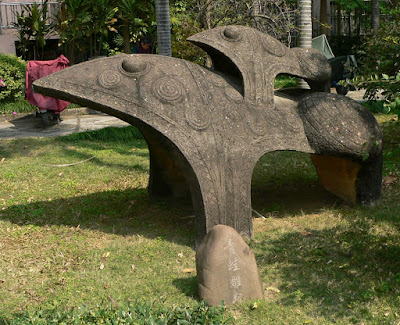Although China is dominated by Han Chinese, there are 55 recognized minority groups. Yunnan province alone is home to 51 of them, and they represent a significant portion of the total population. Guangxi province, which I visited last month, also has numerous minority groups. Why do these provinces have so many?
Portrait of a Miao woman
Yao woman talking to Julie
Yunnan Province, which borders Burma and Viet Nam, is the main province for minority groups. Guangxi Province, which is right next door, also has its share of minority groups.
From Guilin, there are several different types of villages, which are normally visited by tour groups. Yangshuo, south of Guilin is another such area. The large terraced hills north of Guilin are home to several different groups. And many others are known on the basis of rock paintings and distinctive architecture along major rivers.
Huashan rock painting mockup (Museum of Nationalities)
At one time, what is now China was inhabited by several groups of people, but over time the Han became dominant. In southwestern China, people of the Nam Viet were gradually driven off the plains by the Han, and retreated into the mountains, where they survived by farming huge terrace complexes.
Longji terraces, Guangxi Zhuang Autonomous Region
This method of survival was effective in the southern parts of China, where one could at least eke out a living. Surviving ethnic minorities in northern China adapted different strategies. But there is a price to be paid. Watering all those terraces is brutally hard work. Additionally, a major reason that the plains of China were so fertile is the interaction between the rising Himalayan mountains, as they are eroded by monsoon rains, the fresh minerals carried in raging rivers that cross China and episodically flood. The minerals in the soil of the plains is thus replenished on an ongoing basis.
The soils on the mountains--not so much. Notice how small the woman talking to Julie was? All the Yao people we saw were really tiny, even by Chinese standards.
Yao woman with infant
Look at these terraces again.
Longji terraces, Guangxi Zhuang Autonomous Region
This is how you get to water them.
I would hesitate to call this a pump. You stick one end in the water and pump like hell, and the fins draw water up to the next terrace. Basically, just by splashing. I would think that adequate nourishment was historically a problem.
Longji terraces, in Guangxi Zhuang Autonomous Region.
As the Han held the plains, the other people of the region only survived in isolated holdfasts in the mountains. They could survive in the mountains, and the Han probably didn't feel the price worth paying to completely eliminate them, although there were numerous wars in recent centuries.
Although ethnically related, without the ability to maintain communications, eventually the groups began to diverge culturally, until we reached the present situation with many relatively small populations of diverse cultures--islands in sea of Han.
Miao instruments in the Museum of Nationalities.
Consider the
Miao. Despite being a relatively small group, there is a lot of cultural variation among groups living in different parts of China. So much so, that with my untrained eye, I would not recognize them all as part of one ethnic group.
Miao Pavilion in the Nationalities Court, Nanning
The Miao like frogs
Miao costume
The Zhuang are much better represented in Guangxi. They have their own room in the Museum of Nationalities.
Zhuang artifacts in the Museum of Nationalities, Nanning
Zhuang fabrics
Zhuang slippers (top) and flower slippers (below).
As for the
Yao, we have already seen them working on their terraces. At one time they were allied with the Miao in rebellion against the Chinese, but were driven south into mountain holdings. Culturally, they share some properties with the Dong people--their propensity for extremely long hair, for instance.
Elaborate embroidery is another thing the Yao have in common with most of the southern minority groups.
Yao farm implements, Longji terraces.
It isn't all about pumping water up one terrace at a time. They also gather honey.
Despite some cultural similarities with the Dong, their architecture is significantly different.
Yao village, Longji terraces
Dong pavilion, Nationalities Court, Nanning
Dong architecture, Museum of Nationalities
Girls playing catch in front of the Museum of Nationalities.




























































